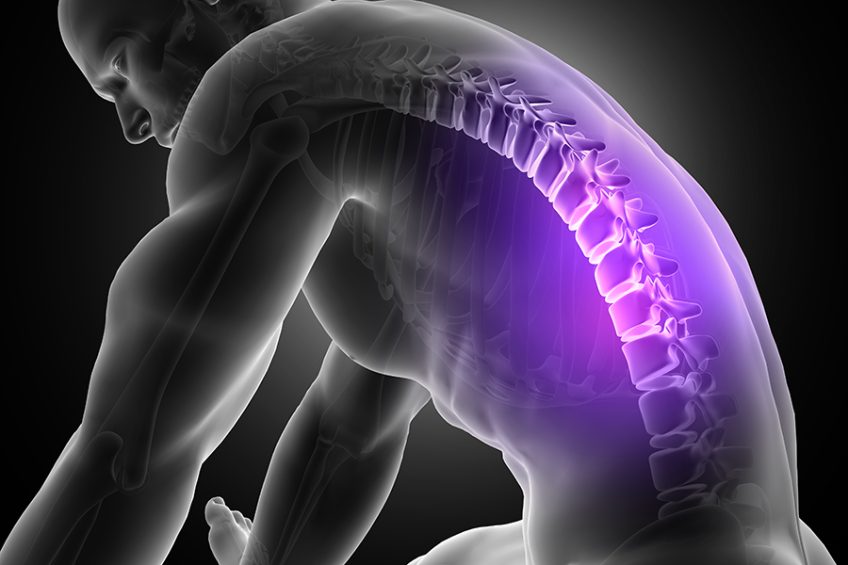Spine pain in children is much rarer, but has a much more serious significance, suggesting an infectious disease, an inflammatory disease or cancer.
Back pain can be caused by both spine disorders and other organs and organs.
Diseases that could cause back pain can be respiratory (pneumonia, lung cancer), cardiovascular (angina pectoris, myocardial infarction), digestive tract (gastric ulcer, chronic pancreatitis), kidney (pyelonephritis, kidney stones) , genital (pelvic inflammatory disease, uterine retroversion).
Spinal pain is extremely common in medical practice and can be caused by:
- congenital factors: as it happens in the spina bifida and vertebral epiphysitis;
- of traumatic factors, as it happens in the fractures of the vertebral bodies and the herniated discs;
- inflammatory factors, such as ankylosing spondylitis and Reiter’s syndrome;
- of tumor factors, as it happens in benign and malignant tumors of the spine;
- metabolic factors, such as osteoporosis, osteomalacia and Paget’s disease;
- degenerative factors, as in spondylosis, dysarthrosis;
- infectious factors, such as Pott’s disease or brucellosis.
CONTENT:
- Characteristics of spine pain
- Tips for protecting your spine
- General principles for the treatment of back pain
Characteristics of spine pain
How does it appear?
Spinal pain can occur suddenly in the case of trauma and herniated disc, or it can occur gradually in degenerative and inflammatory diseases of the spine (spondylosis, spondylitis, rheumatoid arthritis).
When it occurs?
In inflammatory vertebral diseases, the pain appears at rest. In the case of a herniated disc, the pain appears after lifting a weight, after a physical effort or after a sudden movement. In acute lumbago the pain occurs after exposure to cold and moisture.
How intense is it?
Spinal pain can be deaf in degenerative diseases (spondylosis, dysarthrosis, herniated disc) or live in lumbosciatica.
Where is it located?
Spinal pain may affect the entire spine (in inflammatory diseases of the spine) or may be localized to certain segments of the spine (cervical spondylosis, herniated disc).
Where does it radiate?
Spinal pain:
- may remain where it appeared (in lumbago);
- may radiate along a rib – intercostal neuralgia;
- may radiate to the upper limb – cervicobrachial neuralgia;
- may radiate to the lower limb, as in lumbosciatica.
Tips for protecting your spine
A. Sit and walk with your back straight, your abdomen pulled back and your chest pushed forward! When standing for a longer period of time, rest your spine by supporting your body with something or placing your weight on one leg at a time, alternately!
B. Sit in a straight-backed chair with your feet on the floor or pedestal and place a pillow behind your hips. Change your position from time to time! Both the chair and the desk should be the right height, and your hands and elbows should be supported on the desk.
When you get up from your chair, first pull your hips to the edge of the chair, then stand up with your hands on your back and avoid bending your spine.
C. In the supine position, the bed should be elastic, but firm. If you have low back pain, put a pillow under your neck and under your knees, with your body lying on your back.
The spine must be straight and lying down! In a supine position, in order to straighten the spine, a pillow should be placed under the abdomen and one under the ankles. In a supine position, place a pillow under your neck and one between your knees and knees slightly bent.
Lifting from the bed is done as follows: first sit on your side, then raise and lower your legs at the edge of the bed, then, leaning on your hands, stand up.
D. Heavy objects are lifted with the back straight, from the squat position (legs slightly apart, knees bent, back straight), with the object raised close to the torso. It is forbidden to turn the torso to the side when lifting a weight. Heavy objects should be evenly distributed on both arms.
E. While working, the spine must be straight, not bent! If necessary, stay on your knees or with your legs bent!
F. The correct position at the wheel is with the knees at the same level or slightly above the hips, the back supported by the backrest, with the seat close enough to be able to bend the knees and reach the pedals.
G. Strengthening the muscles of the spine can be achieved by practicing a sport: swimming, athletics, gymnastics.
General principles for the treatment of back pain
- Bed rest is recommended for severe pain, acute lumbago, lumbosciatica, osteoporosis.
- Physiotherapy is indicated in cervical spondylosis, lumbosciatica.
- Local heat is applied in acute lumbago and lumbosciatica.
- The administration of antibiotics is done in case of infectious spine diseases.
- Anti-inflammatory drugs, analgesics and muscle relaxants are indicated in inflammatory and degenerative diseases, fibromyalgia, osteoporosis.
- Drugs that inhibit bone resorption and drugs that stimulate bone synthesis are indicated in osteoporosis.
- Medical gymnastics is done under the specialized guidance of a physiotherapist and is indicated in case of spinal deformities such as kyphosis, scoliosis and fibromyalgia.


